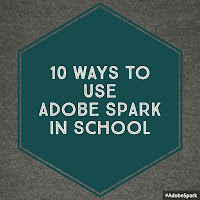On Tuesday morning I published a video about how to use Adobe’s new creative suite called Adobe Spark. That video was focused on how to use the three parts of Adobe Spark; post, page, and video. If you haven’t seen the video, it is embedded below.
Now that we know how the tools work, let’s take a look at some ways that teachers and students can use Adobe Spark.
Post:
Post is the part of the Adobe Spark that lets you create graphics like posters, announcements, and Internet memes.
- Students and teachers can create simple posters to print and post in their schools to announce club meetings, campaigns for class elections, or to post encouraging messages to students.
- To help students understand and show that they understand what propaganda messages look like, I have had them create simple early 20th Century-style propaganda posters of their own. Adobe Spark has built-in Creative Commons search that can help students find pictures to use for those posters. Students can also upload pictures they’ve found in the public domain.
- Create a meme-style graphic to share on your classroom, library, or school website. The graphic could be intended to encourage students and parents to remind each other of an upcoming school event. You could also create a meme to encourage students to continue reading over the summer.
Video:
As the name implies, this is the Adobe Spark tool for creating videos. Videos are created by adding text and images to slides. You can record yourself talking over each slide. A library of free music is available to layer under your narration or you can use that music in lieu of narration.
- Create a short flipped-lesson with Adobe Spark. The recording tool makes it easy to precisely record your narration over the slides in your lesson.
- Have your students create video lessons. The slide aspect of Adobe Spark’s video tool lends itself to students creating short Ken Burns-style documentary videos. Have them use Spark’s search tool to find images to use in their videos or have them use a place Flickr’s The Commons to find historical images. I’ve had students make this style of video to tell the stories of people moving west across the United States in the 19th Century.
- This is the time of year for end-of-school assemblies and celebrations. Use Adobe Spark’s video creation tool to make a video of highlights of the school year. Rather than narrating the video you can use music from Adobe Spark’s library.
- Create an event invitation page. Create a page that outlines the highlights of an upcoming school event like a fundraiser or open house night. Include images of past events, images of prizes, or include a video about the event. Should you need people to register for your event, include a link to a Google Form. (Learn how to use Google Forms).
- Create a digital portfolio. Spark pages provide a great format for digital portfolios. Students can organize their pages into sections to showcase videos they’ve made, documents they’ve written, and their reflections on what they’ve learned.
- Make a multimedia timeline. While it wasn’t designed specifically for making timelines, Spark Page’s formatting does lend itself to timelines. Ask your students to research a series of events, find media representative of those events, caption the events and media with dates, and then place them into the proper order.
- Write an image-based story. Students can write a story about themselves by using pictures they’ve taken placed into a Spark Page. Another way to think about image-based stories is to have students search for images and use them as writing prompts. Ask them to choose five pictures and write a story that connects the images.


